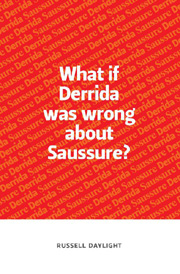Book contents
- Frontmatter
- Contents
- Acknowledgements
- Abbreviations and Textual Notes
- Introduction
- 1 Classical Semiology
- 2 The Originality of Saussure
- 3 The Concept of the Sign
- 4 Writing, Speech, and the Voice
- 5 The Sign as Representation
- 6 Linguistic Identity
- 7 The Sign and Time
- 8 The Horizon of Language
- Conclusion
- List of Works by Derrida and Saussure
- References
- Index
5 - The Sign as Representation
Published online by Cambridge University Press: 12 September 2012
- Frontmatter
- Contents
- Acknowledgements
- Abbreviations and Textual Notes
- Introduction
- 1 Classical Semiology
- 2 The Originality of Saussure
- 3 The Concept of the Sign
- 4 Writing, Speech, and the Voice
- 5 The Sign as Representation
- 6 Linguistic Identity
- 7 The Sign and Time
- 8 The Horizon of Language
- Conclusion
- List of Works by Derrida and Saussure
- References
- Index
Summary
We have so far considered Derrida's engagement with Saussure only in relation to linguistic signs, even if we have had to deliberate the inclusion or exclusion of writing. But the sign is more commonly understood as the basic unit of general semiology, or semiotics, rather than as a strictly linguistic object. Even Saussure, as a linguist, indicates that the linguistic sign is merely part, albeit the most important part, of a more inclusive science (Course: 68/101). And within this field of semiotics, or the science of signs, it is almost universally agreed that the sign conforms to the medieval maxim identified by Jakobson: aliquid stat pro aliquo, or, something that stands for something else. Steven Maras, for example, recently surveyed the semiotic landscape and found that:
From a basic starting point, semiotics can be described as the study of signs, and the sign described as an entity that ‘stands for’ something else. As Umberto Eco writes, ‘when – on the basis of an underlying rule – something actually presented to the perception of the addressee stands for something else, there is signification’ (Eco 1976: 8). Peirce defines the sign as ‘something which stands to somebody for something in some respect or capacity’ (Peirce 1965: 2.228). Articulated in this way, semiotics cannot be restricted to natural communication or systems of representation like speech or writing. As Chandler notes, ‘semiotics involves the study not only of what we refer to as ‘signs’ in everyday speech, but of anything which ‘stands for’ anything else’ (Chandler 2001: 1). Sless refers to the ‘stand-for’ relation as ‘ubiquitous’, and from a semiotic point of view ‘the basis of existence’ (Sless 1986: 3). (Maras 2002: 115)
- Type
- Chapter
- Information
- What if Derrida was wrong about Saussure? , pp. 86 - 107Publisher: Edinburgh University PressPrint publication year: 2011



